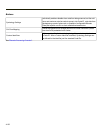
Notes
l When Strip: Code ID (see Symbology panel) is not enabled, the code ID is sent as part of the bar code data to an
application.
l When Strip: Code ID (see Symbology panel) is enabled, the entire Code ID string is stripped (i.e., treated as a Code ID).
l UPC/EAN Codes only: The code id for supplemental bar codes is not stripped.
l When Enable Code ID is set to AIM or Symbol, Custom Code IDs appear at the end of the list of standard Code IDs.
l When Enable Code ID is set to Custom, Custom Code IDs replace the list of standard Code IDs.
l When Enable Code ID is set to Custom, AIM or Symbol Code IDs must be added to the end of the Custom Code ID.
For example, if a Custom Code ID ‘AAA’ is created to be read in combination with an AIM ID for Code 39 ‘]A1’, the
Custom Code ID must be entered with the AIM ID code first then the Custom Code ID : ]A1AAA.
l When Enable Code ID is set to None, Code IDs are ignored.
l Custom symbologies appear at the end of the list in the Symbology dialog, but will be processed at the beginning of the
list in the scanner driver. This allows custom IDs, based on actual code IDs, to be processed before the Code ID.
l When using the parameters in the Scanner Control Panel to manage indicators for good read/bad read decoding, the
number or patterns of beeps heard may be confusing. Rejected bar codes generate a bad scan beep. In some cases,
the receipt of data from an external scanner triggers a good scan beep, and then the rejection of scanned bar code data
by the Scanner Control Panel processing causes a bad scan beep by the mobile device on the same data.
4-135


















